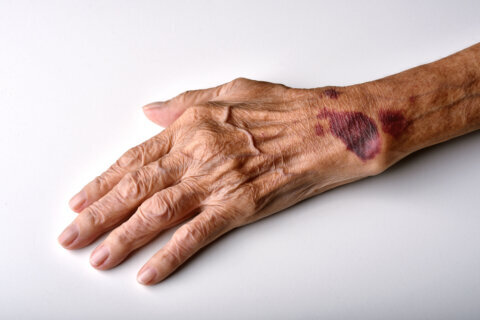A lurking health condition may be at your fingertips – literally. Your nails can provide clues to other health conditions, and specialists at MedStar Washington Hospital Center can help with treating and diagnosing fingernail and toenail conditions.
Nail bumps, discoloration or pain can be signs of other larger issues and should be taken seriously, said Dr. Thomas Stringer, a dermatologist at MedStar Washington Hospital Center.
“Nail pain is something that we always want to evaluate, because that could signal some kind of inflammation or growth that’s occurring in or around the nail,” Dr. Stringer said. “I think that something that people don’t always know is that the same types of cancers that we evaluate and treat on the skin can also occur in the nail. So new things, or new growths that are occurring around there often warrant evaluation as well.”
Dr. Stringer said many people don’t associate dermatologists with being able to help with nail conditions – however, it’s something these specialists are prepared to address.
“Oftentimes people that come to see me, they’ll say things like, ‘Oh, you know, I’ve had this issue with my nails for a long time, but I was always told it was cosmetic. And so … I’ve just kind of been living with it,’” Dr. Stringer said. “And depending on what they might have, it’s not something they necessarily have to live with.”
Some nail concerns can be indictors of something more troubling and require treatment, Dr. Stringer said. There are several common fingernail and toenail conditions that patients should be aware of so they know when to seek medical treatment.
Fungal infections, such as athlete’s foot, are a common nail disorder where nails experience thickening, crumbling or discoloration. They can be painful and make walking difficult, Dr. Stringer said. Treatments include a topical ointment applied to the nails or a pill taken orally.
Discoloration or dark streaks can appear on nails and can be benign moles or cancerous melanomas. Not all dark streaks are cancer, but all should be examined by a dermatologist right away, Dr. Stringer said.
Psoriasis is a common skin condition that presents as scaly, red patches on the skin and on the nails as crumbling, discoloration or pitting. Treatments range from topical psoriasis therapies to steroid injections into the nail unit to oral or injected systemic therapies, he said.
Brittle, soft or splitting nails can be common – especially with advancing age. Some brittle nails can be caused by an iron deficiency. A nail care routine may be recommended to keep nails hydrated and protected, Dr. Stringer said.
Injuries to the nail can cause broken or bruised tissue. Sometimes a nail injury leads to a subungual hematoma where blood gets trapped under the nail, causing discoloration. Dermatologists may drain fluid that is building up beneath the nail to treat the injury, Dr. Stringer said.
With all nail conditions, it can be vital to seek out treatment as soon as you sense something is not right.
“The earlier these are treated, the easier it is to get on top of it and make sure that the problem is addressed pretty quickly,” Dr. Stringer said.
With all treatments, Dr. Stringer said he works to understand the root cause. For example, he works to confirm a fungal growth before diagnosing and treating.
“Unless I have a compelling reason not to, I always try to … establish a microbiological diagnosis — confirm that there is fungus within the nail, before I commit people to a month-long course of antifungal treatment,” he said.
MedStar Washington Hospital Center’s team of dermatologists are thorough and rely on skin checks and other methods to make sure they know the best course of treatment.
“If there’s a pigmented band that’s new for a patient, we often evaluate the nails when we’re doing skin checks to make sure there’s no signs of melanoma, new yellowness, crumbling, disordered growth of the nails that hasn’t responded to prior dermatologic treatments — is good to have evaluated here,” he said.
Dr. Stringer wants people to know they don’t have to keep living with nail discomfort.
“I’m excited to help people in the area who may have considered a problem that they just have to live with or something that’s been intractable — it hasn’t responded to anything,” he said. “And really kind of address the problems of an area that’s often neglected — even within dermatology.”
Read more about nails in a post by Dr. Stringer on the MedStar Washington Hospital Center website.







